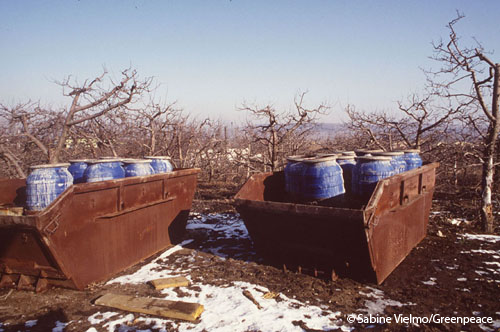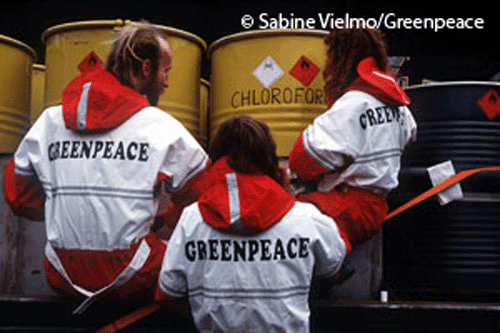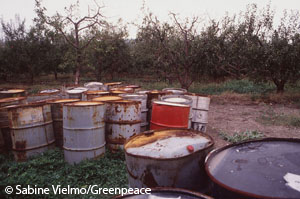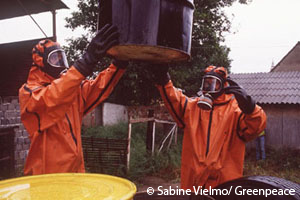
2,000 tons of obsolete pesticides: A trip to Hermannstadt / Sibiu and back
"Only the officially approved hazardous waste exports from West Germany, mostly after neighbouring European countries including in the German Democratic Republic, amounted in 1989 to 520,000 tons, followed by the Netherlands with 250,000, the United States with 141,000, of Switzerland, with 110,000 and Austria with 90,000. There were also world businesses with a huge number of unreported cases. These exports had been neither approved nor illegal, because no export ban exists. They ran as 'commodity'."(Count Andreas Bernstorff, 2008)
November 1990
Scene of action: Romania
The company “Montana S.A.” is founded in Romania. A joint venture between the Romanian Alexandru DAN and Belgian Edouard LEJOY. The company is legally registered nowhere. "An illegal company," judge the police detectives in Bucharest later. Company founder DAN comes from the Romanian village Miercurea Subiului and was formerly a warehouse manager of state farms in the region of Sibiu. LEJOY was previously employed by the “Austrian Airlines” in Bucharest.
Over the course of 1991
Scene of action: Saarland (a German state) and France
The entrepreneur Heinz-Werner HELMCKE is uncovered as a racketeer of waste. His company, “TRI Tyre Recycling Industries” (based in St.Ingbert / Saarland, Germany) took over some 100 tons of waste of middlemen from Ravensburg and Dusseldorf - highly toxic waste, some of it twenty years old. 168 barrels (each containing 200 litres) were smuggled to France. The cargo ended up in an illegal car shredders and scrap tire disposal site in Moselle. Concerned residents had uncovered the matter. HELMCKE is sentenced in absence by the district court of Sarreguemines to a 15,000 € fine and one year in prison without parole.
August 1991
The transported goods of HELMCKE are clearly classified as toxic waste by French and Saxon police detectives
September 1991
Scene of action: Hamburg
Peter SCHMITZ is for the first time in the files of the district court in Hamburg. The owner of the "U. Schmitz Industrie Service" company in Bottrop earned his living as a racketeer of waste. He is convicted of violation of the War Weapons Control Act. He was also involved in the planning of unlawful delivery of helicopters to Iran
September 1991 till May 1992
Greenpeace is able to prove: Wolfgang PELGER, Jürgen HOLZ and Alexandru DAN are racketeers of waste and organized the transport of at least 2,000 tons of toxic waste from the former GDR after Romania: Insecticides, pesticides, paint wastes, contaminated solvents, rat poison and other toxic industrial waste. The waste was transported to the region of Sibiu. Eight illegal landfills were discovered. Responsible are German racketeers of waste and their Romanian partner
October 1991
Scene of action: Saarland
Police detectives seize another part of the cargo of HELMCKE in Merzig / Saarland: 80 tons of toxic waste
October 7th 1991
Scene of action: Bonn
The Counsellor of the Romanian Embassy in Bonn, Vasile CROICU provides the freight forwarder Juergen HOLZ with an excellent cover letter for his toxic waste export. In this letter Mr. CROICU ask the responsible Romanian customs and border authorities, to handle the "aid convoys" of HOLZ`s company "Speedy" quickly. The pesticides would have been allegedly a gift from the "Treuhand” company"
November 1991
Scene of action: Dresden
The “Technogem Dresden” company, a subsidiary of “Technogem Ltd. London”, no longer exists. Until then, the company served Juergen HOLZ (a racketeer of waste) as a letterbox company, in order to give contracts at the Dresden forwarding company "Speedy" to transport obsolete pesticides and industrial waste to Romania. "Speedy" saw to it that the transports were performed by subcontractors. Managing Director of “Speedy” was Juergen HOLZ, a former informer of the Ministry for State Security of the GDR. “Speedy” and “Technogem” were registered at the same address
1992
Scene of action: Berlin
An East Berliner (returned from Romania) brings Greenpeace (Berlin branch), a letter, which was written to the editor to a local newspaper from Hermannstadt / Sibiu. In this letter scientists (chemists and physicians) express their concerns about the consequences of waste exports from EU countries after Romania. Company names are not mentioned. Greenpeace archived the letter under the heading "toxic waste exports".
An informant calls (via car phone) at the Berlin branch of Greenpeace. The caller leaves his phone number. He claims to know that 2,000 tons of obsolete pesticides from Saxony are to be delivered to Romania. The project was already underway. The caller was originally been involved in the action. His motive for the call at Greenpeace can be classified as an act of revenge
March 16th 1992
Scene of action: Hessen (a German state)
In a shed at a station in Hesse obsolete pesticides, paints and coatings were discovered by Greenpeace. These are parts of the released HELMCKE-cargo from Merzig, which appear in Hesse again - at night in a shed nearby the station Guntershausen near Kassel. Greenpeace campaigner Count Andreas BERNSTORFF had discovered the illegal interim storage facility and informed the authorities in Hesse. Unlike their colleagues in Saarland, officials of the Hessian Environment Minister Joschka FISCHER (Greens party) put the "dangerous toxic waste Odyssey" to an immediate end. The tv broadcast ZDF heute journal releases pictures made by Greenpeace. The obviously planned export can be prevented
Scene of action: Saxony-Anhalt (a German state)
Greenpeace has trouble with entrepreneur Peter SCHMITZ, because he is involved in the storage of 5,000 barrels of old pesticides in the Saxon town of Daehre. Toxic waste is waiting there in potato storage for its export to Egypt.
A Greenpeace truck is parked in front of the storage. The truck is decorated with a banner: "Environmental protection directly." While Greenpeace guards the toxic waste, the previously informed press appears. The tabloid Bild am Sonntag subtitled: "The West poisons the East!"
March 1992
Saarland authorities release the freight of toxic waste of HELMCKE (which had been confiscated just in October '91) as an "economic goods". Reason: HELMCKE presents an import license - a questionable Romanian proof of disposal. His Romanian partner had obtained the import license by the Ministry of Trade and Tourism in Bucharest. All barrels disappear from Merzig in the beginning of March - loaded in trucks with Romanian license plates
April 1st 1992
Scene of action: Hesse and Sylt (an German North Sea island)
60 tons of confiscated toxic waste be burned in a hazardous waste incinerator in Hessian Biebesheim. At the expense of the HELMCKE company "TRI" from St. Ingbert. The disposal costs are probably more than 325,000 €. HELMCKE is briefly detained on it - on a beach at Sylt islands. He is in custody on suspicion of fraud in several cases in Saarbruecken
May 1992

Once Campaigner BERNSTORFF had informed the local environmental authorities, 20 tons of toxic waste in 99 barrels in the Romanian county of Sibiu was confiscated. HELMCKE had brought this freight of toxic waste previously to Romania. "Until Greenpeace came up, we had virtually no idea what's going on here," said Romanian investigators
BERNSTORFF calls the international directory assistance and is provided with the phone number of a sports journalist from a German newspaper (Hermannstaedter Zeitung) in Hermannstadt / Sibiu (Romania). This journalist knows nothing of toxic waste, but points to his wife, who is also a journalist and works for the Karpathen-Rundschau. She turns out be a good source
BERNSTORFF meets with the Romanian journalist in Heidelberg. They exchange information. The suspicion of massive toxic waste shipments from Germany is confirmed.
BERNSTORFF notes corruption on a grand scale. Involved are federal agencies and countries, as well as customs and border police
The informant (who had called Greenpeace from the car phone) is contacted by BERNSTORFF. The campaigner questioned him for locations from which the exports have been started. The informant talks about storage facilities for exports within a specific region in Saxony – in the district of Vogtland
Scene of action: Saxony
A 30-year-old Greenpeace researcher and journalist disguises himself as a young entrepreneur (and racketeer of waste) and is equipped with a brisk BMW. He dips undercover in the criminal milieu of toxic waste export.
To protect himself, he initiates the Saxon Office of Criminal Investigation (LKA) of his plans. The undercover researcher will report regularly to the LKA about his whereabouts, if it is possible. The alleged "entrepreneur" looks for three days after suitable halls for the temporary storage of "pesticides". He can identify three potential storage facilities. All are empty - so they are not interesting. But suddenly a hint: The technical manager of a textile company, Henning B., is ready to rent a hall in Oberlungwitz near Chemnitz. However, a visit to the hall would be not possible before next Monday. Because there were "still stuff in there" which has to be transported to Romania. Because there were "still stuff in there" what needs to be transported to Romania. The Greenpeace researcher insists on an immediate inspection of the hall. His demand is finally accepted.
As the researcher entered the hall, he notes a massive toxic stench out of rotten barrels filled with obsolete pesticides. About 40 pallets of various chemicals from the East German agriculture are stored. While inspecting the hall, he discovers the delivery address on the partially leaky barrels: "Alexandru Dan" in the Romanian city of Sibiu
Though the researcher is convinced there were still more such halls in Saxony, he ended his investigation for safety reasons. His report can be found here:
A three-week undercover investigation
Scene of action: Saxony
Greenpeace activists from Berlin are travelling in a car to Saxony. They position themselves nearby the hall in Oberlungwitz / Saxony. They are supposed to report when the trucks with the toxic waste leave towards Romania and follow them
May 12th 1992

Scene of action: Saxony
Two trucks loaded with toxic barrels leave the warehouse in Oberlungwitz towards Czechoslovakia.
Greenpeace activists stop the trucks at in the German-Czech border crossing Schoenberg in the presence of the previously informed media. It turns out that the shipping documents are incomplete and there are false declarations.
The border police are called and journalists film the Greenpeace-banner: "No toxic waste export! Greenpeace!"
The police recognize the poor state of the pesticide barrels and stop the onward journey
The toxic waste transport is discussed in TV evening news: "Greenpeace reveals: German toxic waste was supposed to go to Romania"
Scene of action: Heidelberg
BERNSTORFF learns by phone from one of the truck drivers, the goods are addressed to Alexandru DAN in Hermannstadt / Sibiu. This was already known. But the driver gives also a detailed directions to the final destination Miercurea Sibiului / Reußmarkt
BERNSTORFF learns via his contacts in Transylvania that Alexandru DAN manages warehouses of former agricultural collectives
Scene of action: Romania
BERNSTORFF travels to Hermannstadt / Sibiu. He discovers stored toxic waste from Germany at eight different places in the district. In halls, in basements and on open spaces
BERNSTORFF is now supported by a Greenpeace video team. They film all previously found toxic waste storages and are accompanied by the Romanian Police
BBC broadcasts the Greenpeace pictures worldwide. The Romanian government accuse Greenpeace of damaging the reputation of the country

May 1992
Alexandru DAN is arrested in Romania with 80 million lei (almost half a million DM) in his pocket. He is sentenced to three months imprisonment
May 26th 1992
Federal Environment Minister Klaus TOEPFER promises his Romanian counterpart, Marcian BLEAHU in Dusseldorf, he would personally arrange the transport of the toxic barrels back to Germany
June 1992
Residents of the village Miercurea Subiului near Hermannstadt / Sibiu protest against the toxic dump site and block an interstate highway for two hours.
A commission of German experts of the Federal and States of Saxony and Saarland visits Sibiu and Bucharest. The Commission inspects eight illegal landfills. They discover definitely waste, which have to be disposed "environmentally sound". The result makes clear that the 2,000 tons of toxic waste must actually return to the sender - as required under international treaty to control cross-border waste shipments in 1990
September 7th 1992
A rented farm by the company “Montana S.A.” in Miercurea Subiuliu is visited. BERNSTORFF, the mayor of the town and a police officer confiscate two of the barrels stored at the farm. A Greenpeace transport is due to bring some poison barrels back to Germany - a symbolic act that is intended to emphasize the responsibility of the German authorities
September 9th 1992

Greenpeace activists load on a truck some toxic barrels from illegal landfills in the district of Sibiu. Dressed in protective suits and with gas masks, they add one or two barrels from each of the eight landfills to their cargo. The destination of the cargo is Bonn, Germany: Ministry of Environment (i.e. Minister TOEPFER)
September 16th 1992
Scene of action: Saxony
The symbolic return of the toxic waste barrels rolls is stopped by German customs at the border. The state government of Saxony insists the Greenpeace truck is an import of waste. Thus a waste import application is needed. BERNSTORFF opposes the Customs authorities and remains with 12 tons of toxic waste at the border
Greenpeace calls for the return transport of hazardous waste and its proper disposal in Germany as well as an international ban on export of toxic waste from industrialized countries in the third world and transitional economies in Central Eastern Europe and Central Asia
The Federal government does nothing, says BERNSTORFF
Scene of action: Bonn
In Bonn, the environment ministers of the countries meet with Minister TOEPFER to discuss the subject of waste exports. At the final press conference in the late afternoon, Minister TOEPFER rejects any political responsibility for the toxic barrels from Transylvania at the Saxon border. The 12 tons of waste on the Greenpeace truck would be under the jurisdiction of the federal state of Saxony
September 18th 1992
Scene of action: Saxony
The toxic waste truck from Greenpeace is still at the border. What was planned as a "rolling political demand" (BERNSTORFF) is, however, not stopped. As a "waste-memorial" is the Greenpeace-truck in the headlines of the local press.
It follows an order by the regional council of Chemnitz: Greenpeace should bring the cargo within 24 hours into the "interim storage" Meerane. That is the place; where since four months those trucks with toxic waste were parked, which Greenpeace had stopped to their trip to Romania in May at the border of Schoenberg
On the local parking lot of a former East German company the toxic waste should remain, because no one in Bonn is developing a plan for the disposal of the toxic cargo. BERNSTORFF replied to the regional council of Chemnitz: "If there is no response from Bonn, we are not going to Meerane." The parked Greenpeace truck in Schoenberg does not stir from the spot
End of September 1992
The state of Hesse agrees (after a demand from BERNSTORFF) to take over half of the German toxic waste from Romania and store it in an underground disposal site. The same day arranged Minister of Environment TOEPFER an eviction of the Greenpeace truck at the border
September 24th 1992
Around 4 p.m. two dozen police officers unbolt the Greenpeace truck. Fire-fighters boarded the trailer with heavy equipment. They find eleven Greenpeace activists chained to the toxic barrels. With bolt cutters each Greenpeace activist had to be individually cut loose. Mechanics had to chisel at the ignition lock in order to start the vehicle. After three hours, the nightmare is over. The trailer with the toxic barrels, now coupled to another vehicle, is brought to Meerane
January 1993
Scene of action: Romania
By bursting poison barrels there is the acute danger that at thaw the poisons contaminate the floor. Greenpeace cleaned with own equipment the landfill
The Bucharest government thanks the "company" Greenpeace for its commitment
February 1st 1993
Greenpeace addresses an ultimatum to Minister TOEPFER: He shall order the return of all pesticides in Romania until February 15th. By threatening to bring the poison back to Germany itself, Greenpeace activists continue their cleaning of landfills
February 14th 1993
Greenpeace is informed by Minister TOEPFER that the repatriation is disposed by 450 tons of toxic waste from Romania. The special waste will be now recycled in a proper manner
March 11th 1993
An explosive cargo reaches Germany: A train of 1.3 km in length, loaded with pesticides (which were exported from Germany). At last ...
A great success: Now is Greenpeace heard by the general public
Greenpeace now receives many invitations from police academies, provincial environment ministries, the Federal Ministry of Foreign Affairs, as well as waste management associations
The issue of "toxic waste export" is now also printed by the big players in the print media industry, including:
- DER SPIEGEL, 13/1989: "Absolut hohl"
- DIE ZEIT, 36/1995: "Giftküchen auf Sparflamme"
Now the problem is solved. At least for now.
(MH)
Online am: 19.10.2016
Inhalt:
How Greenpeace successfully fought against toxic waste exports
- An overview of the entire project
- Chronology of a long but successful campaign
- 2.000 tons of obsolete pesticides: A trip to Hermannstadt / Sibiu and back
- Count Andreas von Bernstorff - the Greenpeace campaigner
- Frank BRENDEL - Journalist
- A report from a detective agency - specialized in the issue of toxic waste
- A three-week undercover investigation
